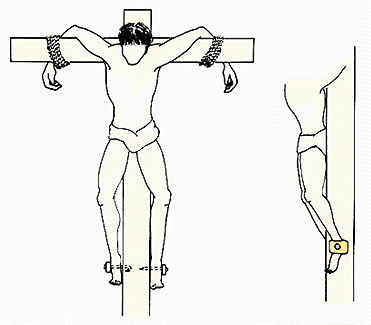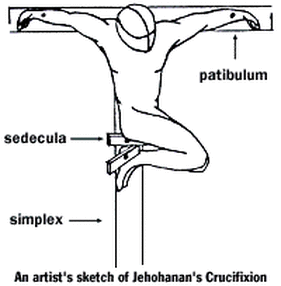CROSS
According to the New Interpreter’s Dictionary of the Bible (NIDB), the word cross has both a metaphoric and literal use (803). Literally, the word cross, in the New Testament refers to the instrument of Jesus’ death. Metaphorically, it refers to the lifestyle of the disciples, who followed Jesus in service, leading up to his crucifixion (Mark 8:34) (803). The NIDB separates the significance of the cross into three different categories including historical reality, theological significance, and spiritual/ethical significance. The first category, historical reality, refers to the humiliation and degradation that Jesus suffered to fulfill his duty to God (803-804). Cross, in this manner, also refers to Jesus’ reshaping the political norm that was established at the time through way of his death being symbolic of a martyr (804). Theologically, the cross is significant through three different areas. These include soteriology, Christology, and theology proper.
1. Soteriology deals with salvation. Salvation, as established by the New Testament, is accomplished by means of Jesus’ sacrifice on the cross. The death of Jesus, as noted by the early Christians, is described as being “for us” (804).
2. Christology deals with things that are of Christ and there interpretations. The cross, in this manner, is important because it shows Jesus’ obedience as the Son of God and reveals his identity as the Savior (804).
3. The last category, theology proper, refers to the doctrine of God. In this manner, the cross not only represents Jesus’ love but Gods love as well (804).
Spiritually and ethically, the cross is an expression of Jesus’s love and the shape and source of salvation (804).
CRUCIFIXION
Crucifixion is a means of execution where a person is nailed to a cross and left to hang there until they die (806). It was first practiced in the eastern Mediterranean and Alexander the Great and his successors were noted as using the practice (806). It was usually reserved for “murderous or rebellious slaves” (806). It was also practiced by Jewish authorities, one such being Alexander Jamaeus who is said to have crucified a number of Pharisees (806). Those that were crucified were posted along highways, hills, and city gates. These were the places that were the most traveled or the most populated so that they could act as deterrents for others who considered rebellious of deviant activities and were carried to their locations by those that were condemned to die on them (806). Victims were usually beaten and then nailed to the cross by their hands and ankles (806). The practice was later used on Christians. Some cross and their individuals carried a titilus, which declared the name and the punishment of the criminal. The titilus for Jesus was written in multiple languages and stated “king of the Jews” (806). It was considered to be the “worst form of death” at the time (807).
According to the New Interpreter’s Dictionary of the Bible (NIDB), the word cross has both a metaphoric and literal use (803). Literally, the word cross, in the New Testament refers to the instrument of Jesus’ death. Metaphorically, it refers to the lifestyle of the disciples, who followed Jesus in service, leading up to his crucifixion (Mark 8:34) (803). The NIDB separates the significance of the cross into three different categories including historical reality, theological significance, and spiritual/ethical significance. The first category, historical reality, refers to the humiliation and degradation that Jesus suffered to fulfill his duty to God (803-804). Cross, in this manner, also refers to Jesus’ reshaping the political norm that was established at the time through way of his death being symbolic of a martyr (804). Theologically, the cross is significant through three different areas. These include soteriology, Christology, and theology proper.
1. Soteriology deals with salvation. Salvation, as established by the New Testament, is accomplished by means of Jesus’ sacrifice on the cross. The death of Jesus, as noted by the early Christians, is described as being “for us” (804).
2. Christology deals with things that are of Christ and there interpretations. The cross, in this manner, is important because it shows Jesus’ obedience as the Son of God and reveals his identity as the Savior (804).
3. The last category, theology proper, refers to the doctrine of God. In this manner, the cross not only represents Jesus’ love but Gods love as well (804).
Spiritually and ethically, the cross is an expression of Jesus’s love and the shape and source of salvation (804).
CRUCIFIXION
Crucifixion is a means of execution where a person is nailed to a cross and left to hang there until they die (806). It was first practiced in the eastern Mediterranean and Alexander the Great and his successors were noted as using the practice (806). It was usually reserved for “murderous or rebellious slaves” (806). It was also practiced by Jewish authorities, one such being Alexander Jamaeus who is said to have crucified a number of Pharisees (806). Those that were crucified were posted along highways, hills, and city gates. These were the places that were the most traveled or the most populated so that they could act as deterrents for others who considered rebellious of deviant activities and were carried to their locations by those that were condemned to die on them (806). Victims were usually beaten and then nailed to the cross by their hands and ankles (806). The practice was later used on Christians. Some cross and their individuals carried a titilus, which declared the name and the punishment of the criminal. The titilus for Jesus was written in multiple languages and stated “king of the Jews” (806). It was considered to be the “worst form of death” at the time (807).




 RSS Feed
RSS Feed